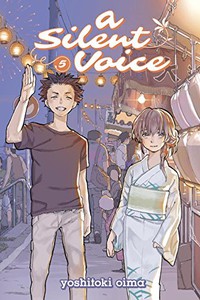Review
by Nick Creamer,A Silent Voice
GN 5
| Synopsis: |  |
||
Summer vacation is approaching, and Tomohiro is still intent on making a movie with all of his new friends. Having recruited everyone who joined him on the trip to the amusement park, Tomohiro sets out to make a film that will do justice to his unshakeable friendship with Shoya. But the seams holding this group together seem ready to split at any time, and given the deeply conflicting motivations of characters like Naoka and Satoshi, it seems likely that when the truth of Shoya's past comes out, these idyllic days will come to an end. Even as he works hard to make up for his past misdeeds, can Shoya truly become a new person in the eyes of his friends? |
|||
| Review: | |||
A Silent Voice's fifth volume opens with a very unexpected change of pace - an action pastiche detailing the adventures of a rough and tumble hero known as Big Friend “N,” who gallantly fights at the side of his, well, big friend. Full of dynamic action panels, dramatic shading, and grim-faced character designs, it's a rip-roaring adventure that for a few pages switches Silent Voice's concerns from the perils of adolescence to “My beloved car, Cathy!” It's a hilarious genre digression for Silent Voice, an extended visual joke utterly sold through a confident shift to a completely new art style. It's a style of diversion fitting for Tomohiro's head, a place where reality is constantly reinterpreted into ideals of heroic action and unbreakable friendship. Unfortunately for Tomohiro, he doesn't live in that world - he lives in our world, where the simple act of gathering a group of kids to make a student film might well ruin all his unstable friendships. The only “hero” in this place is Shoya, whose overprotective feelings towards Shoko make him more of a stifling burden than someone she can actually rely on. There's no guarantee anyone can save these kids from themselves. A Silent Voice is as painful and insightful as ever in this volume, as the various responsibilities and negotiations required for Tomohiro's movie reveal new truths and frictions all throughout Shoya's makeshift group of friends. Even the act of asking to include Shoko in the production involves navigating a variety of tensions; Naoka attempts to override Shoya's desires through volume, while Miki still seems uncomfortable around Shoko, and frames Shoya's feelings as “just including her because she's deaf.” It's ultimately the wildcard Satoshi who ends up supporting Shoya, and as we learn later on, he has his own motivations for this. Satoshi was once the kid bullied, back in his own elementary school days - and even though he's now gained some confidence and popularity, he still wears his past like a bruise. A visit to Shoya's elementary school provides more strong opportunities to demonstrate the diverse psychologies of these characters, as Shoya's insecure conversations with his old, callous teacher end in Satoshi literally throwing a bottle of water in the teacher's face. “Respectability” comes off as far less important than fundamental character, but there are still no simple ideals of just behavior to rely on. Even if Satoshi's feelings are based in concern for the little guy, his own past gives him a seething, binary perspective on villains and victims. His black and white view of morality makes him a very awkward friend for someone like Shoya, who spends all of his time attempting to make up for his own former violence. Things get even more tense in the volume's second half, as Shoya's very real need to devote time to studying runs up against Tomohiro's insecurity and constant performance of friendship. Shoya has finally reached the point where he sees his classmates as people with their own motivation, as opposed to just figures whose relevance hinges on how they feel about him, but his slow path towards greater maturity is beset by all kinds of personal-baggage landmines. And when Satoshi's hatred of bullies leads Shoya to pressure Miki into not telling Satoshi the truth about his own past, the house of cards comes tumbling down. In a painfully sincere climactic argument, Miki attempts to defend her own past situation, Naoka accuses Miki of simply playing innocent, and Shoya tries to take all the blame for the situation on himself, spitting out his worst possible thoughts about all his new friends. It's a blistering setpiece in a series normally defined by quiet tension, and a strong reflection of just how good this series is at giving every single one of its characters a rich interior life. A Silent Voice's art retains its usual overall strength and slight issues in this volume. Standout sequences like the art switch from the opening chapter are a great new touch, and the physicality of the characters is still expressed quite well, but there are still some awkward expression hiccups here and there. Satoshi suffers the worst of this - his base design burdens him with a default impression of secretly plotting some evil scheme, which makes it hard to parse more nuanced variations in his emotions. But those feelings are certainly clear enough in his words and actions, as he joins the rest of the cast in their textured, poignant richness. A Silent Voice continues to be a best-in-class drama in its fifth volume. |
| Grade: | |||
|
Overall : A
Story : A
Art : B+
+ Retains A Silent Voice's painfully precise character work, and tops its character articulation off with some well-earned dramatic setpieces. |
|||
| discuss this in the forum (9 posts) | | |||
| Production Info: | ||
|
Full encyclopedia details about Release information about |
||